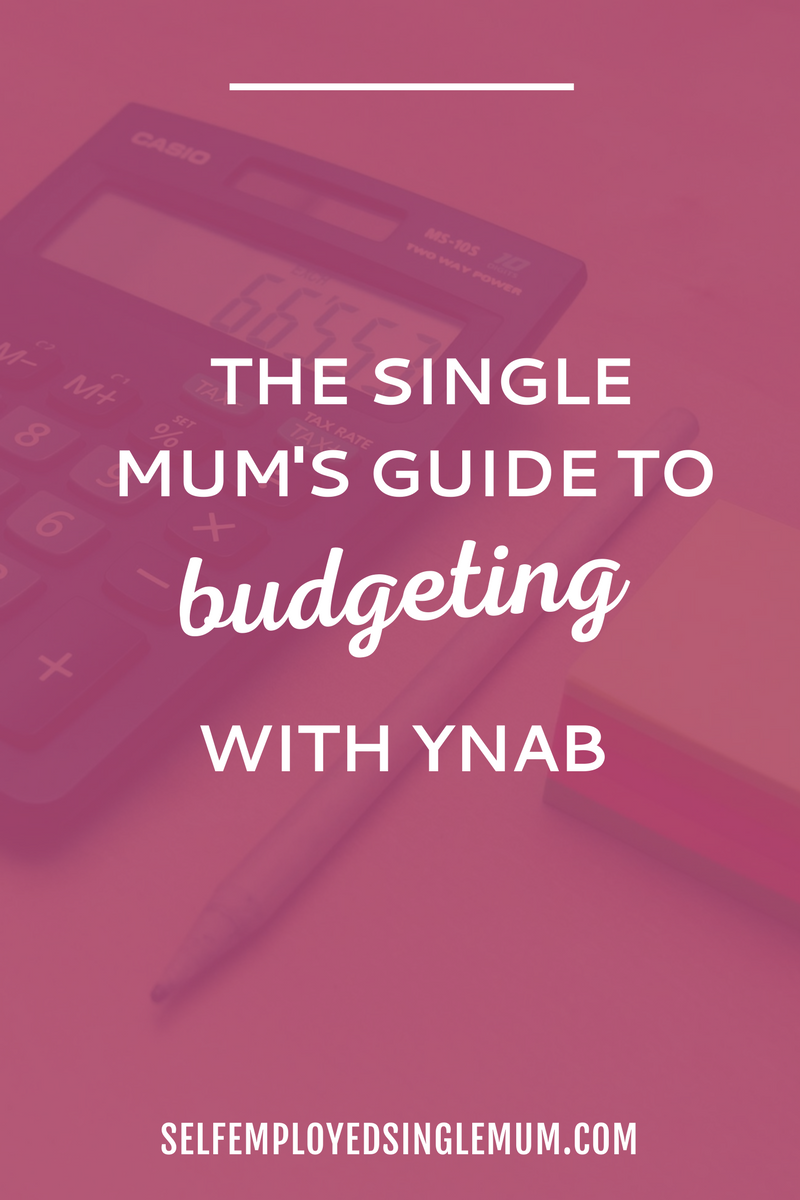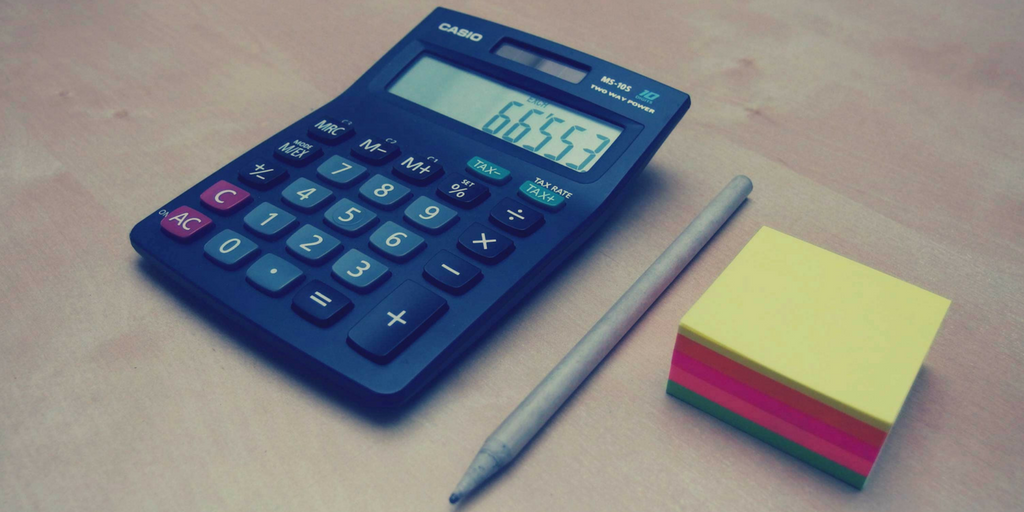The single mum’s guide to budgeting with YNAB

OK today I’m sharing THE best piece of advice I was given when I was thinking about quitting my job to become self-employed.
Start budgeting with YNAB.
I’d posted in a Facebook group for freelancers and entrepreneurs asking for advice from any single parents in the group. I wanted to know how they coped financially because the one thing that was holding me back was money worries.
How was I going to make sure I had enough to pay the bills? Was it irresponsible to even consider ditching a reliable pay packet?
Money is probably THE biggest source of stress and worry for single mums. Being worried about money seeps into every part of your being. I know, I’ve been there.
So I’m forever grateful to the couple of people who advised me to use You Need A Budget (YNAB) to get to grips with my living expenses and manage my income.
YNAB has transformed my relationship with money. I honestly believe EVERY household should use YNAB to budget. Whatever your financial situation YNAB will help you improve it. I have no doubt.
So that’s why I’m paying it forward and sharing that valuable piece of advice with you.
Let’s dive in and get into the nitty-gritty.
Why do you need a budget?
Hopefully, as you’re reading this post you’re already know you need a budget. But just in case you need an extra shove in the right direction, here’s WHY you need one.
Firstly, I believe all women, no matter their circumstances should be financially independent and take responsibility for their personal finances. Being in control of how you’re spending your money is key to that – and that’s essentially what a budget is.
Here are a few other advantages of budgeting:
- Creating a budget is key to knowing how much you need to earn to cover all your basic living expenses which is essential if you’re living on a small, reduced or irregular income.
- A budget will help you figure out what are essential expenses and where you can cut back.
- If you want to start improving your financial situation, for instance if you want to get out of debt or save for the future, creating a budget is the first step.
- It will also serve as an early warning system at times when money is tight. You’ll know in advance if you need to cut back and be able to take steps to make sure the essential bills get paid. No nasty surprises.
- Being in control of your budget is transformational. It’s an important mindset shift. You’ll no longer feel out of control when it comes to your finances. You’ll be the one pulling the strings, not the other way around.
[label type=”primary”]Related:[/label] How to manage your money: 6 simple steps to financial freedom on a single income
What is YNAB?

YNAB is an online budgeting tool like no other. There’s an online desktop version and a mobile app for both IOS and Android so you can take it with you everywhere.
The beauty of it is that it doesn’t just record what you’ve spent it helps you plan, control and prioritise your future spending.
It works is like a fancy online version of the old-fashioned envelope method of budgeting. You set up your budget categories and when you get your income you assign an amount to each of categories according to your priorities. The budgeting gurus at YNAB call this ‘giving every dollar a job’ – it was created in the US, but you can work in ££s.
Then as you go about your life spending your hard-earned cash, you record your spending in YNAB and are able see at a glance how you’re doing against your budget. If you overspend in one category you know you have to reduce what you’ve spent somewhere else.
The app means that you can enter your spending on the go plus you can upload transactions from your bank account.
So it does take a bit of effort, but you soon get into the swing of it, and it really helps you be mindful about what you’re spending.
What are the benefits of budgeting with YNAB?
Budgeting with YNAB has transformed my relationship with money. I had tried all kinds of budgeting techniques – keeping it all in a spreadsheet, using apps that tracked my spending. But none of it helped me manage what I was spending or plan for upcoming expenses.
Here’s what I’ve achieved by budgeting with YNAB:
- I managed to live off a very small and irregular income for nearly two years when I was only living off my self-employed income. I knew exactly where I could cut back to stay within my budget.
- I’m no longer caught off guard by big annual – but completely predictable – expenses, like car insurance, that previously I always failed to set aside money for and would end up whacking on a credit card. Now I use YNAB to set goals for those categories and set aside money each month so when it’s time to pay-up the money is there.
- My current account hasn’t gone overdrawn since I started using YNAB in March 2015.
This year my YNAB budget has helped me:
- save a £1000 emergency fund in just a few months.
- put aside nearly £500 towards Christmas.
- pay off both my credit cards in full.
- start putting away a set amount each month towards next summer’s holiday.
Admittedly, the improvement in my ability to save this year is down to other factors, not just YNAB. But by using YNAB I’ve made sure that the extra money I have now is being used to help me reach my financial goals, and I’m not frittering it away as it might have done before.
What are the drawbacks of budgeting with YNAB?
OK, so YNAB isn’t perfect, but it comes close. Here’s what you might not like about it:
It takes time and effort. You do need to be committed to your financial goals because budgeting with YNAB does a bit of effort. But any budgeting system that actually works takes commitment. I’ve found that once you’re in the swing of things it’s not a big deal. You might actually enjoy it. I do, but then I’m a bit of a money geek and get a kick out of being in control of my finances.
If you’re in the UK you can’t automatically load your bank transactions. YNAB doesn’t sync with UK bank accounts yet. But you can download your transactions from your bank account and then upload them to YNAB. I do this once a week and it takes about two minutes, however automatic upload would be nice. Are you listening nice people at YNAB?
It’s not free. Paying for a budgeting app may feel counter-intuitive but this is one of those times when you get what you pay for. YNAB costs around £40 ($50) a year, but there’s a 34-day free trial, and it’s definitely saved me WAY more than that in the nearly three years I’ve been using it.
How to budget with YNAB
I’ve been budgeting with YNAB long enough to have my process down to a fine art. I’m not always totally up-to-date with entering all my spending but it doesn’t take long to catch up.
Categories
I thought it would be helpful to share how I’ve set up my budget categories. You can use groups to define different types of categories and these are mine:
- NEEDS – set in stone. These are the non-negotiable living expenses that have to be paid no matter what. For instance, my mortgage, car payments, council tax, mobile phone, broadband.
- NEEDS – savings can be made. This is stuff I have to pay for but I can reduce the amounts by living frugally eg. groceries, petrol, gifts, day-to-day spending money
- WANTS – the nice-to-have stuff that in a pinch I can ditch eg. personal care, restaurants, clothes.
- ANNUAL NEEDS – for the big essential stuff like Christmas, car/home insurance, my daughter’s birthday, home maintenance.
- SAVINGS – I’ve got categories for all the things I’m saving towards. Emergency fund, holidays, my daughter’s junior ISA.
Monthly budget update
Here’s what I do at the start of each month:
- enter and reconcile the previous month’s transactions.
- allocate any available income to the all my budget categories and play around with it until it all balances.
- check how much I’ve allocated to the categories in my ‘annual needs’ group and transfer that amount to a separate savings account so I don’t spend it!
- transfer any other savings amounts to the relevant accounts.
At the moment I have three sources of income – my part-time job, the rental income from my house, and my self-employed income. The first two are paid to me by the 1st of the month so I’ve usually got a really clear idea of whether there’s enough to cover everything or if I need to transfer some cash over from my business account too.
Weekly upkeep
Every week I do the following:
- enter cash spending as I go on the app.
- import my bank account transactions on a Sunday night and adjust my budget categories if I need to.
This means I always have a clear idea of how I’m doing against my budget. I just need to check my phone. For instance, before I do the grocery shop I can avoid overspending by checking how much is left in the groceries category before I throw those extra items in my trolley.
[label type=”primary”]Related:[/label] How to save money on food shopping (the quick & simple way!)
Also, if I find I need or want to buy something I haven’t budgeted for I can see if I can tfrom another category to cover it.
For instance today I decided to buy a light to help me with Seasonal Affective Disorder – I’m not a fan the dark English autumn-winter days. I didn’t have £50 in my ‘health & fitness’ category, but as it’s nearly the end of the month I could see I had money leftover in other categories that I could move across. If I didn’t have it I would have had to dip into my savings or wait until next month.
I hope this post has gone some way to persuading you that budgeting with YNAB is a great way to get in control of your finances.
Money is something that is always a huge worry for single mums and I know using YNAB has helped give me peace of mind. I’ve been able to get out of debt, start saving towards my goals and shift my whole money mindset.
